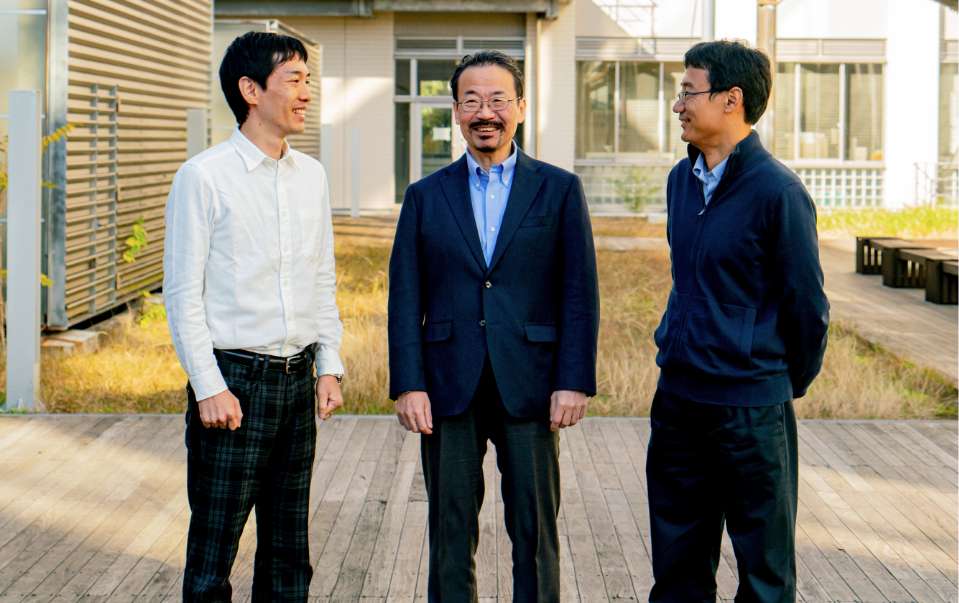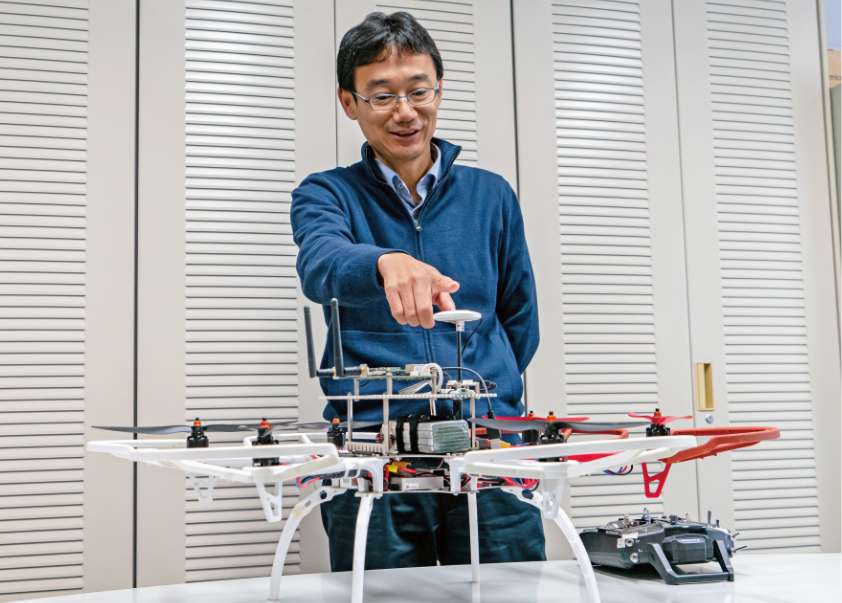Research
Research Group
Interview with the staff of Masaaki Katayama's Laboratory
Welcome to the Wireless World!
This is some kind of science magic!


The research topic of Masaaki Katayama's laboratory is "wireless communication systems." Wireless communication is a method of transmitting information literally without using wires. It uses not only invisible radio and ultrasonic waves but also visible light waves as communication media. On Earth, and even in outer space, modern society is filled with wireless communications as a means of information exchange, and the importance of wireless communication systems is increasing. However, since we don't see much of it directly, it's difficult to understand "wireless communication" even though we seem to understand it, so we asked the Masaaki Katayama's laboratory members about it.
Wireless communications with a wide range of capabilities

Professor
Masaaki Katayama
profile
Born in Kyoto, Japan, he graduated from the Department of Communications Engineering, Osaka University in 1981. After graduating from the Ph. D. course of Osaka University in 1986, he worked as an assistant professor at Toyohashi University of Technology and as a lecturer at Osaka University before joining Nagoya University in 1992. He has been a member of IMaSS since its beginning when the institute was named at Nagoya University. He has been consistently engaged in the research on wireless communication systems. He is interested in the application fields of wireless communication, such as the fusion of control and communication, smart communities, underwater and space frontier communications.
His main hobbies, in order of oldest to youngest, are Amateur Radio (he has the first-class license in Japan, and US extra class), Esperanto, weight training, and Sado (the traditional tea ceremony). He is a craft beer lover.
First of all, could you tell us about "wireless communication"?
Katayama:Wireless communication is a technology for sending information in space without using wires. There are three main media for transmission: radio waves, ultrasonic sounds, and light waves (though they are also radio waves). Wireless communication is a very broad concept. The largest academic society in the field of science and engineering is an Institute of Electrical and Electronics Engineers, and it can be roughly divided into three sections: “computers,” “communications,” and "others." However, only a few laboratories at universities are involved in communications. For example, at Nagoya University, we are the only one currently working on wireless communication systems.
This field is still growing rapidly, but it is surprising that only a few labs are working on it.
Katayama:I think there is a historical reason for this. The field of electric power was expanding, and the field of semiconductors was growing, and then the field of communications and computers came along at the same time. Communications, especially wireless communications, cover a very broad area. Radar is also part of wireless communication; it sends radio or ultrasonic waves, and receives their echoes or bounces to calculate the distance by demodulated signal. A car's bumper beeps when it is about to hit a bump. It's also a Radar. GPS location information is also part of the world of communication.
What kind of research do you mainly do in Katayama Lab?
Katayama:At the moment, my major themes are "optics," "fusion of control and communication," and "power line communication." We are focusing on optical communications, partly because Nagoya University is deeply involved in LEDs, as represented by Professors Akasaki and Amano, and partly because it does not require a license (radio communication requires a license). Light is also highly confidential, as it cannot be interfered with or leaked from outside once the shutter is closed, for example, indoors.
Communicating with LEDs
I didn't know that "optical communications" can be done wirelessly instead of using optical fiber (a cabled system).
Katayama:Exactly. Professor Okada and Associate Professor Kobayashi put the information on the image shown on the display (monitor). In my case, I use an LED as a transmitter that changes information to the light (infrared light), and with the receiver, restore the light wave to the original information (the transmitted data).
Is it possible to communicate over such a distance?
Katayama:The most common distance is about 30 cm, but we have achieved long-range communications of up to 25 m, the longest distance at the academy. But the amazing thing about light is that it can reach and fly into/from outer space (because you can see the light of stars), and what's more interesting is that it can travel through water. Radio waves hardly pass through water. When I was a high school student, I went to university because I wanted to do underwater communication, something new that no one else was doing, and I think I'm finally going to be able to start that research.

You can retrieve "hidden information" from the display!?

Associate Professor
Hiraku Okada
profile
Born in Nagoya and raised in the countryside outside Nagoya, he attended high school in Nagoya City. He received his Ph.D. in Engineering from the Department of Electronics and Informatics, Nagoya University, Japan, for research on wireless packet communications. As a postdoc, he spent three months as a visiting researcher at the University of Edinburgh. He has worked at Nagoya University, Niigata University and Saitama University before returning to Nagoya University as an Associate Professor.
● His likes and hobby: He learned to operate a computer at elementary school. He likes to go for a drink, and to go camping. He sometimes goes skiing. Nowadays his children ask him to play soccer with them.
What does it mean to use optical communication and put it on the display?
Okada:The data are embedded invisibly in the image shown on the display, which is then captured by a camera and the data is transmitted. With ordinary Wi-Fi, it's difficult to pinpoint where the signal is coming from, so it's hard to know which device is transmitting, but with the display, you can see where it's coming from, so if you point the camera of your smartphone at it, for example, you can get the information.
Do you mean that you send out other information invisibly from signage, etc., and users can get that (other) information when they point their smartphones at it?
Okada:Yes. For example, in a public place such as a train station, it is possible to put an English voice explanation on a display written in Japanese without interfering with the advertising media. With the current AR*1 system, it is possible to point it at the display and type a few more words, and it can also be used as a new advertising medium.
It would be fun to see such a display screen in a meeting place like Crystal Square, a kind of mecca for meeting people.

Drones to be a useful base for disaster mitigation
By the way, you have a drone in your lab.
Okada:We're also working on a communication system for disasters with the use of drones. When a disaster occurs and the cell phone network breaks down, if you fly a drone to a high place as a radio station, it will be able to cover a fairly large area. We used to focus on simulations, but now we're actually experimenting by flying the drone up to 20 or 30 meters high. We're building several of them to create a network.
How long does the battery power last?
Okada:About 20 minutes. If you just want to fly the drone on the spot, you can fly it with the power cord attached and the battery will never run out, so you can keep flying for a while. Legally, you can fly it up to 100m high, which is the same as having an antenna at its height, but if you want it to fly from place to place, you have to use a mobile battery. It's mostly just putting it together, so it's not hard. The harder part is the programming.
Can students also do programming?
Okada:Some students can do it and some can't, but we teach them to do the basics: C or shell scripting. The basics are made in C and then assembled. For machine learning and AI programs, we also use Python. There are some students who like programming and can do it, but most of them go to information science courses, so there are many who can't do it at first.
Professor Okada, have you been familiar with programming since you were a small child?
Okada:I didn't get into this kind of thing until I was in university, but I have always liked programs, computers, and electronic crafts. I used to program and create games on MSX*2 computers, which were popular for a while. Well, my name "Hiraku" comes from a mathematician named Hiraku Toyama*3, so I had no choice but to study mathematics, or perhaps it was inevitable that I would like mathematics.
Using an electrical outlet for communication
What is the other main research theme, power line communication?
Katayama:It is the use of 100-volt electrical outlets to transmit/receive radio-frequency communication signals. I know that's not wireless, but it's a theme I've been working on for about 25 years now. Even if you are surrounded by reinforced concrete walls, as long as there is an electrical outlet, you can communicate.
In order to save energy, the whole process of generation, transmission, storage, and consumption of energy has to work in cordination, and this is where information and communication comes in. For example, when there is a surplus of electricity produced by solar cells in the home, the electricity is supposed to be sent from the power station to the home, but it flows backwards. The question of what to do with the surplus electricity is a very serious matter. To solve this problem, you need communication.
Basic Knowledge
*1 AR
AR stands for Augmented Reality and is called "augmented reality". When viewed through a smartphone or AR glasses, AR adds navigation, 3D data, video, and other digital content to the real world, appearing on the screen to supplement the "missing" or "supplementary" information in the real world.
*2 MSX
A common standard for 8-bit and 16-bit personal computers proposed by Microsoft and ASCII in 1983 (1980s). A number of consumer electronics manufacturers joined the market, and a variety of models were released by each company. It was widely used not only for programming, but also as a game machine because of its design, which did not require a dedicated monitor, its low price, the inclusion of BASIC as a standard feature, and the fact that it was available from many companies.
*3 HIRAKU TOHYAMA
HIRAKU TOHYAMA (1909-1979) mathematician and educator. After dropping out of the Department of Mathematics at the University of Tokyo, he studied mathematics at Tohoku University. He was interested in mathematics education and criticized Japanese school education for placing too much emphasis on not allowing students to make mistakes, for example by assigning students too many difficult problems in junior high school mathematics education, such as factoring and proofs of geometry.
*4 smart grid
A smart grid is a power grid that can control and optimize the flow of electricity from both the supply and demand sides. In Japan, it is also called the next-generation power grid or smart community. Smart grids, which use communication networks to manage the energy supply source to the end-consumption part in a limited area such as offices and factories, are especially called microgrids.
*5 sensor network
A network of many wireless sensors arranged to collect information from wireless sensors ; one of the core technologies of the IoT, which Associate Professor Okada is also working on.
Text extracted from "IMaSS NEWS Vol. 08" Special Issue, IMaSS Publicity Committee (T. Miwa and M. Konishi)
[English translation by J. C. Oates]



